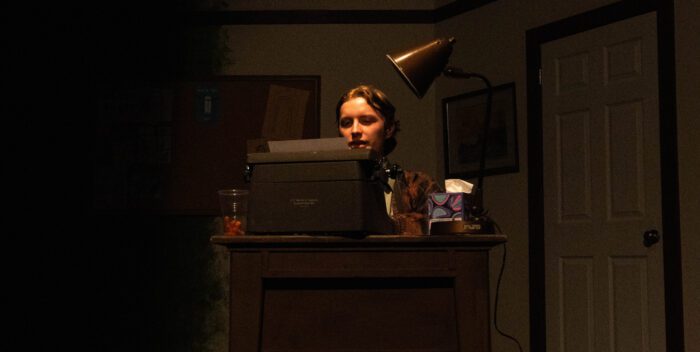“WhoDunit…and to Whom?” brings the comedy of “meta-theatre” to Concordia’s Black Box
Sophomore Jason Church, as Harold Finnegan, works at his typewriter to write his detective story.
Photo credit: Isaac Herrington
By Josiah Horvath
A cast of 19 Concordia students performed the spring mainstage play “WhoDunit… and to Whom?”, a meta-theatrical blend of comedy and contemplation that drew audiences of their peers and community members to a weekend of shows.
The play packed audiences into the Black Box Theatre in the Borland Center over the weekend of March 28-30. The plot follows Harold Finnegan, played by sophomore Jason Church, a salesman and struggling aspiring playwright, whose detective story takes on a life of its own. His characters, also known as “thought-forms,” have grown discontent with his shoddy storytelling and begun revising the narrative for themselves.
However, a man named Montgomery, played by freshman Duncan Carrasco, claims to be the author and causes everyone to freeze when he appears on the stage. After Montgomery tries to have Harold killed by his own supposed thought-forms, they have a duel-by-writing to discover who the real author is.
At first, the battle seems in Montgomery’s favor, but the mysterious Dolores, played by sophomore Sarah Stepp, claims to have a connection to the true author and turns the tide by assisting Harold.
Then Shelley, played by sophomore Catherine Vyhlidal, comes out from the audience, claiming to be the true author—but then she, too, is frozen. Following the freeze, Dolores quietly steps up and claims authorship.
Freshman Simon Blankenship came and watched with friends. He enjoyed the play and praised those responsible for bringing it to life.
“The play certainly has a deeper meaning than just being a comedic jab at the so-called fourth wall,” he said. “I think it is trying to point out that sometimes we feel completely in control of our destiny while at other times we feel incapable.”
Professor of Communication & Theatre Arts Bryan Moore said he’d known about the play for ten years and the size and makeup of the actor pool allowed this play to be done with its larger-than-normal cast size.
“I was intrigued by the humor and layers of meta-theatre that existed through the conversations between the writer and his thought-characters,” Moore said. “The play makes us think about how stories come together in our heads as writers, and if our thoughts can ever take over our intended plans, for better or worse.”
Moore said the configuration of the Black Box was changed for the show, thanks to flexibility incorporated into the theatre’s design. He said the set was designed to “blend two locations on one stage,” and included three doors that allowed actors to change costumes and characters quickly.
The versatility of the space will offer opportunities for more variety and use of technology in future productions, Moore said.



















